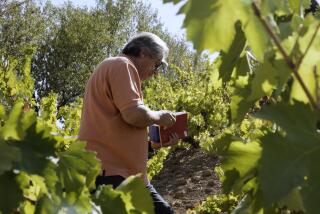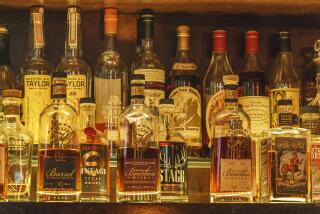Wine cork makers seek to put a stop to declining sales
The worldâs wine cork producers want you to know theyâre sorry.
Two hundred fifty years of market dominance may have left a whiff of complacency. They didnât always listen to your gripes about cork taint â that awkward moment when you pop open your prized cabernet and it smells like wet dog.
------------
FOR THE RECORD
Wine corks: An article in the Dec. 7 Section A about the wine cork industry misspelled the name of the countryâs leading synthetic cork producer Nomacorc as Normacorc.
------------
And they paid dearly. Screw tops that once sealed only ânicheâ booze like Night Train now cap about 2 in every 10 bottles of table wine in the world, even the expensive ones. Plastic cork demand has also surged and now accounts for more than 10% of global market share.
âWe got the proverbial kick in the pants,â said Carlos de Jesus, communications director for Corticeira Amorim, the worldâs biggest cork company, based in the worldâs biggest cork producing country, Portugal.
In a bid to win back customers, the natural cork industry has launched a new advertising campaign directed at Northern California winemakers. Winning their favor is crucial â the U.S. is now the frontline of the global wine industry, having surpassed France as the top consumer by volume this year.
The campaign highlights sustainable harvesting and builds off technical improvements that cork makers say theyâve achieved in driving down incidences of taint. Then thereâs the intangibles: The bottle stops are essential to making the right impression during the gift-giving season.
âAny wine worth its grapes deserves natural cork,â says the ad tag line, which is being aired on four major Bay Area radio stations and featured in digital media ads.
At the core of the message is tradition. âOne of the happiest sounds in the world is the pop of a bottle,â De Jesus said. âWhy would you want to do away with that?â
The advertising blitz adds one more layer to an enduring debate within the $290-billion global wine industry: how best to plug up that pricey bottle of juice.
Natural cork producersâ global market share has declined over the last decade from about 95% to 70%. In response, theyâve invested hundreds of millions in new technology and testing to address cork taint, and theyâve launched a series of marketing campaigns funded by the Portuguese government, including the latest, which cost more than $4 million.
âThis has been a pretty hot debate for years,â said Andrew Waterhouse, a wine chemist at UC Davis who has researched all manner of bottle closures. âEssentially, the natural cork producers realized they were losing market share and had to do something. Theyâve been pushing back really hard.â
Bottled wine needs oxygen to develop its complex flavors, and breathable cork has been the answer since the 18th century. Itâs not perfect, of course. Oenophiles know a percentage of cork-sealed wine can be ruined by too much exposure to oxygen or tainted by trichloroanisole, better known as TCA.
The chemical compound is caused by a natural fungus in cork that takes only the smallest trace to impart an overpowering mustiness in wines, likened to everything from a wet pooch to sweaty gym socks.
âHumans are like the bloodhounds for this compound; we can smell it in the parts per trillion,â said Doug Fletcher, head winemaker for the Napa-based Terlato Wine Group.
The cork industry said manufacturing upgrades over a decade ago have driven the percentage of TCA-tainted wines down to less than 1%, though some critics say itâs closer to 5% or more.
It was a big enough problem that, starting in the 1970s, wine producers in Australia and later New Zealand began eschewing the time-honored cork cylinders for aluminum caps that could be twisted off and resealed.
The change was originally met with skepticism. PlumpJack Winery in Napa Valley, the first high-end American producer to take a chance on screw caps in the late 1990s, was scorned for making the switch.
âWe got faxes and voice messages saying âYour career is over,â âItâs a screwy ideaâ and that restaurants would have to start charging a âscrew fee,ââ said John Conover, PlumpJackâs general manager.
That was short-lived. The metal caps have garnered widespread acceptance in New World wine-producing regions such as the U.S. â especially for varietals like sauvignon blanc that are supposed to be consumed a year or two after bottling.
At the same time, plastic corks began making inroads with some of the biggest wine producers in America by offering competitive pricing and predictable performance.
âOur corks never crumble and never break,â said Jeff Slater, director of global marketing for the North Carolina-based Normacorc, which produces about 90% of the plastic corks in the U.S. and now seals more than one-tenth of the wine produced globally.
âWe still use cork for our high-end wines,â said Fletcher of Terlato. âWe use the screw caps for competitive priced wines. But if you ask me, I prefer using more screw caps.â
One reason why: The technology for wine cork alternatives keeps evolving.
The wine landscape has been littered with these next big things, from the MetaCork to the Zork. Amorim, the Portuguese cork giant, and the worldâs largest glass container manufacturer, Owens-Illinois Inc., partnered last year to release a twist-off cork called the Helix. Meanwhile, winemakers like Fletcher are bullish on a breathable screw cap called VinPerfect.
The Napa-based companyâs founder and chief executive, Tim Keller, developed the product to solve what he called screw capsâ stinginess with oxygen and corksâ inconsistent structure. So the former Sonoma and Napa County winemaker made a cap, fortified with a liner, that allows precise amounts of oxygen through. The caps are tailored to a wineâs aging requirements.
âAt some point, you realize the debate is over tradition versus quality,â said Keller, who has more than 150 wineries using his caps today. âAnd at the end of the day, the cork industry is the horse versus the car.â
Corey Beck, president and director of winemaking at Francis Ford Coppola Winery, said itâs premature to signal corkâs demise. Alternative closures are a relatively new technology. No one knows if they can preserve a fine wine for decades. Cork, on the other hand, is a simple, proven product. âCork has history on its side,â said Beck, whose winery is among five that are partnering with the cork industry in the current marketing campaign. (Bogle Vineyards and Jordan Vineyard & Winery have also signed on.)
Beck is actually a fan of screw caps. Coppola recently launched a brand of wines that cost about $15 under the Gia label that utilizes the metal caps.
âThe best thing that happened to the cork industry was the introduction of screw caps,â Beck said. âIt forced them to look at how they were doing business and then develop new technology.â
While the debate over how to seal a bottle of wine rages on, the outcome may have little consequence to the typical consumer. âIt doesnât really matter what the closure is for the vast majority of your day-to-day wine that you buy inexpensively from a grocery store and drink that week,â said Waterhouse, the UC Davis chemist. âYou can seal it with aluminum foil and a rubber band and it would be fine.â
âThat said, for many people, a bottle of wine is a special purchase,â Waterhouse added. âThe ceremony of using a corkscrew is important, even if itâs a $10 bottle.â
More to Read
Inside the business of entertainment
The Wide Shot brings you news, analysis and insights on everything from streaming wars to production â and what it all means for the future.
You may occasionally receive promotional content from the Los Angeles Times.











